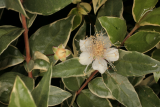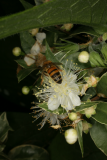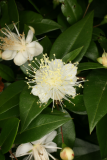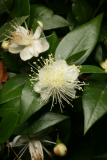Additional notes (click to expand)
Medicinal
Myrtus communis L. Myrtaceae Myrtle 'Variegata' Distribution: Europe. Dioscorides (Beck, 2005) recommends the fruit for treating haemoptysis (‘spitting blood’) and cystitis, and, if boiled, he said it made a fine wine. In various forms it was used as a hair dye, for sore eyes, anal and uterine prolapse, dandruff and shingles, all sorts of inflammations, scorpion bites and even sweaty armpits. Our plant has white berries, but he regarded those with black berries (they become black later in the season) as being more effective. Lyte (1578) adds that the juice of the berries kept the hair black and stopped it falling out, and prevented intoxication. He notes that it only flowered in hot summers in England, but it is reliable in flower now, either due to global warming or selection of suitable clones.
Oakeley, Dr. Henry F. (2013). Wellcome Library notes.
link
Nomenclature
According to Lyte (1578), it is named after Merlyne, a fair maiden of Athens in ancient Greece, who judged the athletic games. Slain by a disgruntled competitor, the goddess Minerva brought her back as the myrtle tree in perpetual memory.
Lyte, Henry. (1578). Nievve Herball or Historie of Plantes.
Myrtus communis L. 'Variegata'
Family: MYRTACEAEGenus: Myrtus
Species: communis L.
Cultivar: 'Variegata'
Distribution summary: Garden origin
Habit: Shrub
Garden status: Currently grown
Garden location: Pharmacopoeia Londinensis 1618 'Leaves' (HSE 6B)
Reason for growing: Medicinal




